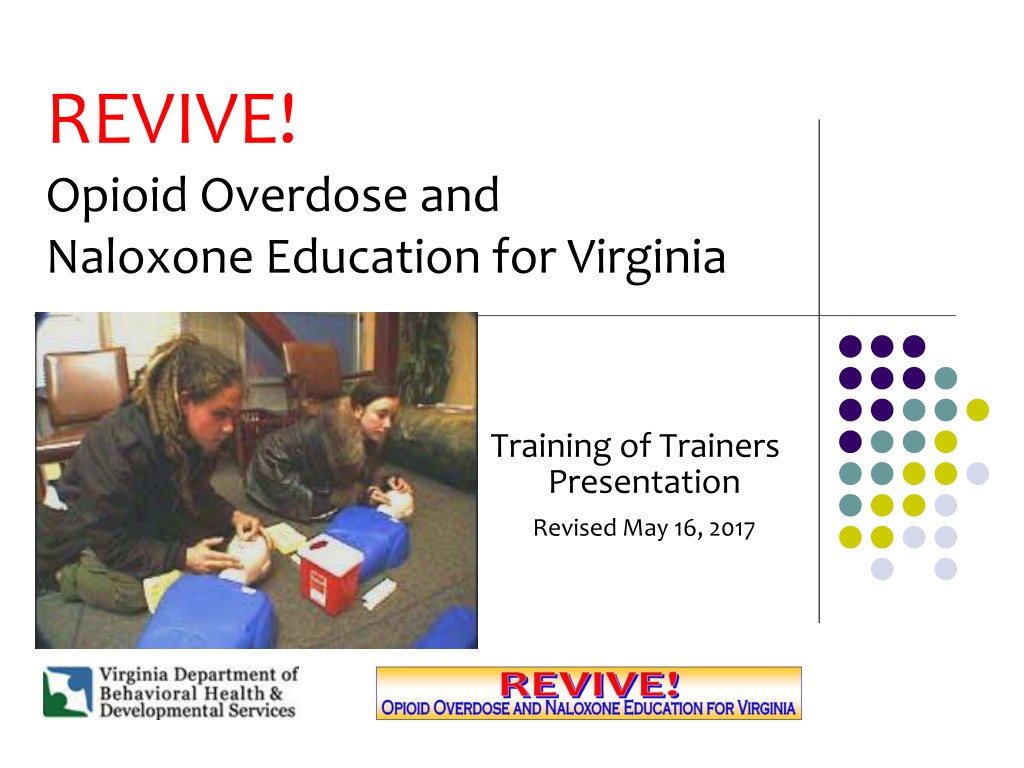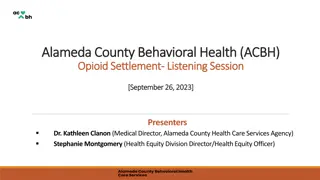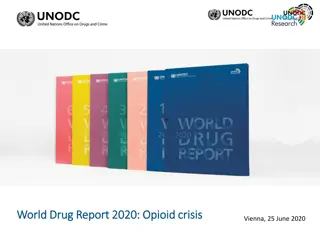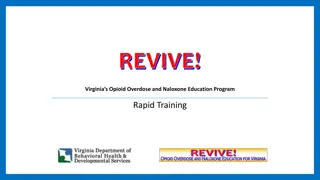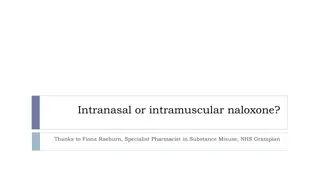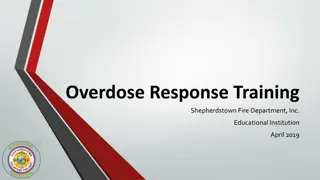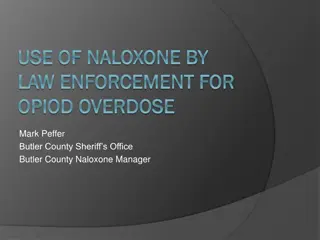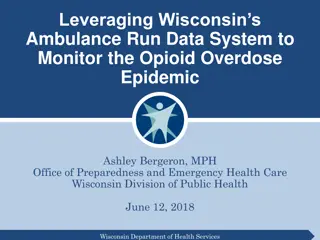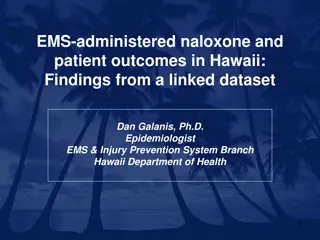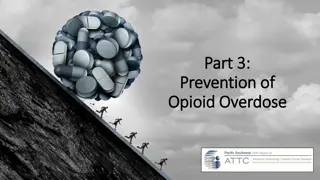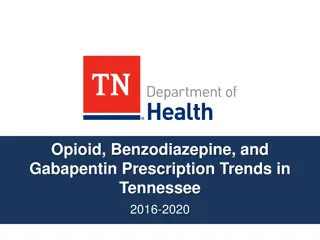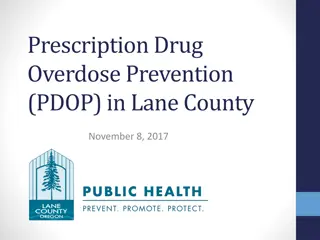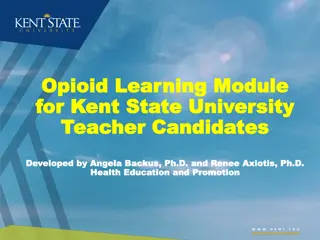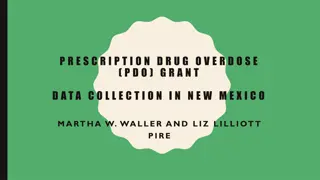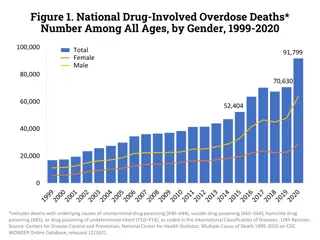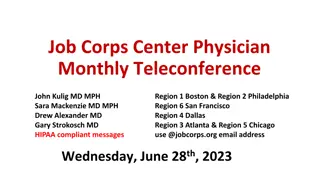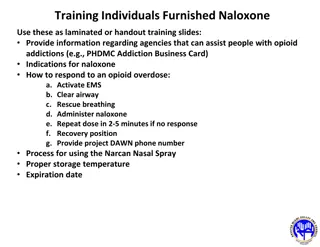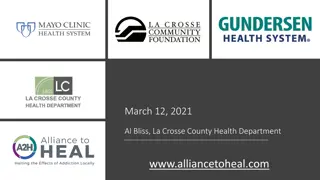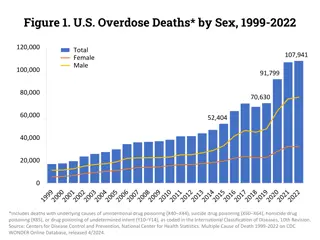Understanding REVIVE! Opioid Overdose and Naloxone Education Training
This presentation covers the REVIVE! training program in Virginia, focusing on opioid overdose response, naloxone education, legislation surrounding safe reporting of overdoses, and the goals of training lay rescuers in recognizing and reversing opioid overdoses.
Download Presentation

Please find below an Image/Link to download the presentation.
The content on the website is provided AS IS for your information and personal use only. It may not be sold, licensed, or shared on other websites without obtaining consent from the author. Download presentation by click this link. If you encounter any issues during the download, it is possible that the publisher has removed the file from their server.
E N D
Presentation Transcript
REVIVE! Opioid Overdose and Naloxone Education for Virginia Training of Trainers Presentation Revised May 16, 2017
REVIVE! Responding to an Opioid Overdose Emergency Welcome and Introductions Please sign in Please complete a registration form Overview of Trainer Handbook and REVIVE! Kit
REVIVE! Goals of Training of Trainers Events Today s Objective: To learn how to train lay rescuers to respond to an opioid overdose emergency, including: Understanding addiction, opioids, how overdoses happen and how to recognize them, and how naloxone works Identifying causes and risk factors for opioid overdose Clarifying common myths about overdose reversal Instructions for how to assist in the reversal of an opioid overdose How to schedule and lead a successful training
REVIVE! Background Legislation in 2013 and 2015 Immunity from Civil Liability Opportunity for oral, written or standing order Current State of Emergency Statewide Standing Order Law enforcement and firefighters can carry and administer Safe Reporting of Overdoses law for 2015 (Next slide) 2017 Naloxone Dispensing (Next slide)
REVIVE! Background Safe Reporting of Overdoses The 2015 General Assembly also passed House Bill 1500 and Senate Bill 892 which allow for the safe reporting of overdoses. These bills allow a person to assert an affirmative defense against the following charges: unlawful purchase, possession, or consumption of alcohol pursuant to 4.1-305 possession of a controlled substance pursuant to 18.2-250 possession of marijuana pursuant to 18.2-250.1 intoxication in public pursuant to 18.2-388, or possession of controlled paraphernalia pursuant to 54.1-3466. To be able to assert an affirmative defense, ALL of the following criteria must be met: You must in good faith seek or obtain medical attention for yourself or someone else experiencing an overdose emergency by reporting the event to a firefighter, emergency medical services personnel, a law enforcement officer, or an emergency 911 system; You must remain at the scene of the overdose or an alternate location which you or the person who suffered the overdose has been transported until a law enforcement official responds to the reported overdose. If no law enforcement officer responds, you must cooperate with law enforcement as indicated and described in the other sections; You must identify yourself to the law enforcement officer who responds; If requested by a law enforcement officer, you must substantially cooperate in any investigation of any criminal offense reasonably related to the controlled substance or alcohol that led to the overdose; and The evidence for the prosecution of an offense was obtained as a result of the individual seeking or obtaining emergency medical attention. Finally, an affirmative defense may not be asserted if you sought or obtained emergency medical attention during the execution of a search warrant or during a lawful search or arrest.
REVIVE! Background 2017 Naloxone Dispensing at Trainings 54.1-3408 A person who is authorized by the Department of Behavioral Health and Developmental Services to train individuals on the administration of naloxone for use in opioid overdose reversal and who is acting on behalf of an organization that provides services to individuals at risk of experiencing an opioid overdose or training in the administration of naloxone for overdose reversal and that has obtained a controlled substances registration from the Board of Pharmacy pursuant to 54.1-3423 may dispense naloxone to a person who has completed a training program on the administration of naloxone for opioid overdose reversal approved by the Department of Behavioral Health and Developmental Services, provided that such dispensing is (i) pursuant to a standing order issued by a prescriber, (ii) in accordance with protocols developed by the Board of Pharmacy in consultation with the Board of Medicine and the Department of Health, and (iii) without charge or compensation. The dispensing may occur at a site other than that of the controlled substance registration provided the entity possessing the controlled substances registration maintains records in accordance with regulations of the Board of Pharmacy. A person to whom naloxone has been dispensed pursuant to this subsection may possess naloxone and may administer naloxone to a person who is believed to be experiencing or about to experience a life-threatening opioid overdose.
REVIVE! Addiction Defined Addiction is a primary, chronic disease of brain reward, motivation, memory and related circuitry. Dysfunction in these circuits leads to characteristic biological, psychological, social and spiritual manifestations. This is reflected in an individual pathologically pursuing reward and/or relief by substance use and other behaviors. Addiction is characterized by inability to consistently abstain, impairment in behavioral control, craving, diminished recognition of significant problems with one s behaviors and interpersonal relationships, and a dysfunctional emotional response. Like other chronic diseases, addiction often involves cycles of relapse and remission. Without treatment or engagement in recovery activities, addiction is progressive and can result in disability or premature death. http://www.asam.org/quality-practice/definition-of-addiction
REVIVE! Understanding Addiction Addiction is: A switch from positive to negative reinforcement Transition from low motivation (wanting to use) to high motivation for use (needing to use) Development of tolerance and physiological dependence A chronic and relapsing disease in which individuals are not able to discontinue use on their own
REVIVE! Understanding Opioid Overdose What causes an opioid overdose?
REVIVE! Understanding Opioid Overdose Too much opioid consumption interrupts neurotransmitters in brain Central Nervous System becomes depressed Breathing and heart rate slow and eventually stop
REVIVE! Types of Opioids Generic Trade Street Hydrocodone Lortab, Vicodin Hydro, Norco, Vikes,Watsons Oxycodone Oxycontin, Percocet Ox, Oxys. Oxycotton, Kicker, Hillbilly Heroin M, Miss Emma, Monkey, White Stuff Schoolboy, T-3s Morphine Kadian, MSContin Codeine Tylenol #3 Fentanyl Duragesic Apache, China Girl, China White, Goodfella, TNT Drop Dead, Flatline, Lethal Injection, Poison, Tango & Cash, TNT Dill, Dust, Footballs, D, Big-D, M-2, M-80s, Crazy 8s, Super 8s Carfentanil Wildnil Hydromorphone Dilaudid Oxymorphone Opana Blue Heaven, Octagons, Oranges, Pink, Pink Heaven, Stop Signs Dillies, D, Juice Meperidine Demerol Methadone Dolophine, Methadose Meth, Junk, Fizzies, Dolls, Jungle Juice Dope, Smack, Big H, Black Tar Heroin N/A Buprenorphine Bunavail, Suboxone, Subutex, Zubsolv Sobos, Bupe, Stops, Stop Signs, Oranges
REVIVE! Recognizing Opioid Overdose What are some of the ways you can tell the difference between someone who is just really high versus someone who is experiencing an opioid overdose emergency?
REVIVE! Recognizing Opioid Overdose There are certain signs you can look for to tell if someone is really high or overdosing. These include: Really High Overdosed Muscles become relaxed Pale, clammy skin Speech is slowed or slurred Breathing is infrequent or has stopped Sleepy-looking Deep snoring or gurgling (death rattle) Unresponsive to any stimuli Responsive to shouting, sternal rub or ear lobe pinch Normal heart rate and/or pulse Slow or no heart rate and/or pulse Normal skin tone Blue lips and/or fingertips
REVIVE! Naloxone How does naloxone work? Opioid Naloxone has a stronger affinity to receptors than the opioid, so it knocks the heroin off the receptors for a short time and lets the person breathe again. the opioid Naloxone Opioid receptor
REVIVE! Naloxone Is naloxone safe? Pure antagonist, no potential for abuse Same dose for an adult or child, labeled as safe for use for pregnant women and children Rare and mild side effects No danger in case of accidental administration Works ONLY on opioids, no potential for side effects if person is using multiple substances
REVIVE! Risk Factors for Opioid Overdose What are some of the risk factors that can make someone more likely to overdose on opioids?
REVIVE! Responding to an Opioid Overdose Emergency Risk factors for opioid overdose emergencies include: Prior Overdose Reduced tolerance previous users who have stopped using due to abstinence, illness, treatment, or incarceration Mixing drugs combining opioids with other drugs, including alcohol, stimulants or depressants. Combining stimulants and depressants DO NOT CANCEL EACH OTHER OUT. Using alone Variations in strength/quantity, or changing formulations (e.g., switching from quick acting to long lasting/extended release) Medical conditions such as chronic lung disease or kidney or liver problems
REVIVE! Responding to an Opioid Overdose Emergency Myths about overdose reversal: What are some myths you have heard about ways to reverse an opioid overdose?
REVIVE! Responding to an Opioid Overdose Emergency There are many myths about how to reverse an opioid overdose. Here are some, and why you SHOULD NOT DO THEM. DO NOT put the individual in a bath. They could drown. DO NOT induce vomiting or give the individual something to drink. They could choke. DO NOT put the person in an ice bath or put ice in their clothing or in any bodily orifices. Cooling down the core temperature of an individual who is experiencing an opioid overdose is dangerous because it can further depress their heart rate. DO NOT try and stimulate the individual in a way that could cause harm, such as slapping them hard, kicking them, or other more aggressive actions that may cause long-term physical damage. DO NOT inject them with any foreign substances (e.g., salt water or milk) or other drugs or force them to eat or drink anything. It will not help reverse the overdose and may expose the individual to bacterial or viral infection, abscesses, endocarditis, cellulitis, choking, etc.
REVIVE! Responding to an Opioid Overdose Emergency Myths about responding Opioid Overdose Emergencies key point of emphasis: Naloxone is the only effective response to an opioid overdose emergency!
REVIVE! Responding to an Opioid Overdose Emergency How to respond to a suspected opioid overdose emergency: Check for responsiveness - if unresponsive or shallow/irregular breathing is present, proceed to step 2 ADMINISTER NALOXONE and Apply Sticker Rescue position; Call 911 Initiate rescue breathing if the person has not yet started breathing. Assess and respond based on outcome of first naloxone administration 1. 2. 3. 4. 5.
REVIVE! Responding to an Opioid Overdose Emergency Check for responsiveness 1. Put on latex-free gloves from the REVIVE! kit. Try to stimulate them. You can shout their name, tap their shoulder, or pinch their ear lobe. Give a sternal rub. Make a fist and rake your knuckles hard up and down the front of the person s sternum (breast bone). This is sometimes enough to wake the person up. Check for breathing. Put your ear to the person s mouth and nose so that you can also watch their chest. Feel for breath and watch to see if the person s chest rises and falls. If the person does not respond or is not breathing, proceed with the steps listed below.
REVIVE! Responding to an Opioid Overdose Emergency 2. Administer naloxone INTRANASAL Pull the yellow caps off the syringe. Pull the purple (may also be red or gray) cap off the naloxone capsule. Screw the atomizer, which looks like a white cone, onto the threaded end of the syringe. Gently screw the naloxone capsule into the syringe, open end first, until you feel it catch. Put the tip of the spray device into one nostril and push on the capsule to spray half of the naloxone into the nostril; immediately switch to the other nostril and spray the other half of the naloxone into the nostril (see diagram below). The capsule has gradient marks to indicate when you have sprayed half of the medication. 1. 2. 3. 4. 5. Please Note: If someone is dependent on opioids, giving them naloxone may result in temporary withdrawal. This response can include abrupt waking up, vomiting, diarrhea, sweating, and agitated behavior. Withdrawal is extremely unpleasant, but NOT life threatening and will only last until the naloxone has worn off.
REVIVE! Responding to an Opioid Overdose Emergency Administer naloxone
REVIVE! Responding to an Opioid Overdose Emergency Video How to Prepare Naloxone for Administration trainingvideo.png
REVIVE! Responding to an Opioid Overdose Emergency EVZIO has visual and voice instructions that help guide the user through the injection process. Each EVZIO auto-injector contains only one dose of medicine. Caregivers should pinch the thigh muscle when injecting EVZIO into a child under the age of one. Pull EVZIO from the outer case. Do not go to Step 2 (Do not remove the red safety guard.) until you are ready to use EVZIO. If you are not ready to use EVZIO, put it back in the outer case for later use. 2. Pull off the red safety guard. 1. To reduce the chance of an accidental injection, do not touch the black base of the auto-injector, which is where the needle comes out. If an accidental injection happens, get medical help right away. Note: The red safety guard is made to fit tightly. Pull firmly to remove. Do not replace the red safety guard after it is removed. 3. Place the black end against the middle of the outer thigh, through clothing (pants, jeans, etc) if necessary, then press firmly and hold in place for 5 seconds. If you give EVZIO to an infant less than 1 year old, pinch the middle of the outer thigh before you give EVZIO and continue to pinch while you give EVZIO. Note: EVZIO makes a distinct sound (click and hiss) when it is pressed against the thigh. This is normal and means that EVZIO is working correctly. Keep EVZIO firmly pressed on the thigh for 5 seconds after you hear the click and hiss sound. The needle will inject and then retract back up into the EVZIO auto-injector and is not visible after use.
REVIVE! Responding to an Opioid Overdose Emergency NARCAN Product of AdaptPharma designed for intranasal use. Place the person on their back. Tilt the head. Administer full dose into one nostril. We will view a video demonstrating how to use. i t 1- Peel back off of package, to remove device. Hold device with t thumb on bottom of plunger and two fingers on either side of the nozzle. 2 Place and hold the tip of the nozzle in either nostril until your fingers touch the bottom of the patient s nose 3-Press plunger firmly to release the entire dose into the patient s nose
REVIVE! Responding to an Opioid Overdose Emergency 3a. Recovery Position If you have to leave the person while they are still unresponsive, put the person in the recovery position. If necessary, place the overdose victim flat on their back. Roll the person over slightly onto their side. Bend their top knee. Put the person s top hand under their head for support. This position should keep the person from rolling onto their stomach or back and prevent them from asphyxiation in case of vomiting. Make sure the person is accessible and visible to first responders; don t close or lock doors that would keep first responders from being able to find or access the person.
REVIVE! Responding to an Opioid Overdose Emergency 3b. Call 911 [If you have to leave the person alone to call 911, put the person in the recovery position see details below]. Quiet down the scene, or move to a quieter location. Speak calmly and clearly. State that someone is unresponsive and is not breathing. You DO NOT have to mention drugs or overdose when calling 911 unless specifically asked by the 911 dispatcher. Give the exact address and location. If you re outside, use an intersection or landmark. When first responders arrive, tell them it is an overdose and what drugs the person may have used, and what you have done so far to respond. PLEASE NOTE: Complications may arise during or as a result of opioid overdose emergencies. Also, naloxone only works on opioids, and the person may have overdosed on something else, e.g., alcohol or benzodiazepines. Calling 911 to request Emergency medical services is critical.
REVIVE! Responding to an Opioid Overdose Emergency 4. Initiate Rescue Breathing Tilt the person s forehead back and lift their chin (see diagram above). Place breathing mask on person s face, covering their mouth and nose. Ensure that the plastic piece is in the person's mouth. The mask has a nose printed on it to guide proper placement. Pinch the person s nose and give normal breaths not quick or overly powerful breaths. Give three breaths, one breath every five seconds. PLEASE NOTE - Brain damage can occur after three to five minutes without oxygen. Rescue breathing gets oxygen to the lungs quickly. Once you give naloxone, the person may not start breathing on their own right away. You may have to keep breathing for the person until the naloxone takes effect or until emergency medical services arrive.
REVIVE! Responding to an Opioid Overdose Emergency 5. Conduct assessment and respond as appropriate Most individuals will recover after a single dose of naloxone is administered. When this occurs, the person will be in withdrawal, which may include abrupt waking up, vomiting, diarrhea, sweating, and nausea. They may not remember overdosing. In rare cases, the person may recover into acute withdrawal, which in addition to the above, may include aggressive, combative, or violent behavior. In this case, the Lay Rescuer needs to ensure their own safety.
REVIVE! Responding to an Opioid Overdose Emergency 6. Conduct assessment and respond as appropriate (cont.) Assessment and Response after First Administration of Naloxone If person recovers but relapses into overdose after 30-45 minutes, recheck for responsiveness, then perform rescue breathing and naloxone administration as appropriate If person does not recover within three minutes, return to step four and administer second dose of naloxone If person recovers, monitor until emergency medical services arrive
REVIVE! Responding to an Opioid Overdose Emergency 6. Conduct assessment and respond as appropriate (cont.): 1st DOSE SUCCESSFUL! If person recovers after the first dose of naloxone, continue to monitor them until emergency medical services arrive. Do what you can to calm and soothe them They may be agitated and will want to take more drugs Do not allow them to take more drugs or eat or drink anything Emphasize the importance of waiting for emergency medical services to arrive so they can be assessed Tell them that opioid withdrawal is not life-threatening and that naloxone will wear off in 30-45 minutes Depending on what substances they were taking, they could relapse into overdose once the first dose of naloxone wears off
REVIVE! Responding to an Opioid Overdose Emergency 6. Conduct assessment and respond as appropriate (cont.) NOT SUCCESSFUL There are two cases in which you may need to administer a second dose of naloxone: SITUATION A: If the individual has not responded to the initial dose within three minutes SITUATION B: If the individual has relapsed into an overdose again after having previously recovered with the initial dose.
REVIVE! Responding to an Opioid Overdose Emergency 6. Conduct assessment and respond as appropriate (cont.) SITUATION A: The individual has not responded to the initial dose within three minutes When this occurs: Naloxone should take effect within 30-45 seconds but may take longer Wait three minutes (continue rescue breathing during this time) At three minutes, administer second dose of naloxone If person remains unresponsive after the second dose is administered, continue rescue breathing until emergency medical services arrives.
REVIVE! Responding to an Opioid Overdose Emergency 6. Conduct assessment and respond as appropriate (cont.) SITUATION B: The individual has relapsed into an overdose again after having previously recovered with the initial dose. Naloxone has a very short half life 30-45 minutes. In some cases, there is so much opioid in the system that the person can relapse back into overdose after the naloxone has worn off. When this occurs: Recheck person for responsiveness as described in Step 1 above. If unresponsive, administer second dose of naloxone Continue rescue breathing until person recovers or until emergency medical services arrives.
REVIVE! Responding to an Opioid Overdose Emergency 6. Conduct follow-up and next steps Summary Calling 911 before administering naloxone is vital. An individual who has overdosed needs to be assessed by medical professionals. The administration of naloxone to an individual is not the last step in responding to an opioid overdose emergency. Further attention and action are necessary. Withdrawal is awful but not life-threatening. Try to keep them calm, let them know what happened, and explain that help is coming and they need to wait for emergency medical personnel to respond. Monitor the individual to see that they start to breathe and become responsive.
REVIVE! Responding to an Opioid Overdose Emergency 6. Conduct follow-up and next steps Summary (cont.) Resume rescue breathing if the person has not started breathing on their own. Naloxone takes several minutes to kick in and wears off in 30-45 minutes. The person may relapse into an opioid overdose emergency after the naloxone wears off. Therefore, it is STRONGLY RECOMMENDED that you watch the person for at least an hour or until emergency medical services arrive. Do not let them ingest food, drinks, or more drugs. Apply the I ve Received Naloxone sticker from the REVIVE! kit somewhere visible on the person which can let first responders know that the person has experienced an overdose and received naloxone. If the person is in withdrawal, their skin may be sweaty or clammy. To ensure it stays, apply the sticker to the person's clothing or hair.
REVIVE! Responding to an Opioid Overdose Emergency Hands-On Training Take this chance to practice sternal rubs, rescue breathing, and assembling the naloxone syringe for administration.
REVIVE! Planning a Lay Rescuer Training The REVIVE! Training Agreement provides helpful information about how to schedule and hold your own REVIVE! training in your community. Reimbursement Forms Mileage Naloxone prescription How you get one What about EVZIO?
REVIVE! Planning a Lay Rescuer Training REVIVE! Training Agreement (Cont.) Logistics Location Publicity Lead time for DBHDS delivery of materials Supplies, Equipment, and Curriculum Kit bags Other materials Training Guides, extra training supplies, mannequin Managing your Training Event Trainings must be provided free of charge! Arrive early and prepared! Maintain fidelity to curriculum Be sensitive to triggers Collect and submit evaluations, registrations, and sign-in sheets
REVIVE! Planning a Lay Rescuer Training Expectations You are not required to lead a specific number of trainings, but please lead trainings when you can as you are able Keys to a successful training: Know your material! Show up early and be prepared! Make sure trainees complete registrations/evaluations Read your audience Get your trainees involved! The more prepared and comfortable you are, the better your trainees will learn and understand the material!
REVIVE! Materials Needed for Trainings Take home REVIVE! kit for each participant which contains: Latex- free gloves and rescue breathing masks Two mucosal atomizer devices (MAD) Information card, return cards, and I ve Received Naloxone stickers Additional gloves, rescue masks, and MADs for training (provided by DBHDS) One unused (or water refilled) naloxone prescription in box (like what a trainee would receive from a pharmacy) Blank registration forms for individuals who have not registered in advance Evaluation forms CPR mannequin Copies of the Training Guide for registrants as well as extras for walk ins A table for demonstrations and hands-on training A computer, data projector, and blank space on which to display PowerPoint slides is not necessary, but you may find it beneficial. Some training locations may be able to provide a computer and/or data projector for use. Alternately, you can use an easel with newsprint or a dry erase board.
REVIVE! Responding to an Opioid Overdose Emergency Questions and Answers Discussion
REVIVE! Responding to an Opioid Overdose Emergency Acknowledgements Boston Public Health Commission Chicago Recovery Alliance Delegate John O Bannon, R-73 Joanna Eller Harm Reduction Coalition The McShin Foundation Massachusetts Department of Public Health Multnomah County (OR) Health Department New York City Department of Mental Health and Hygiene Ed Ohlinger One Care of Southwest Virginia Project Lazarus SAARA Recovery Center of Virginia San Francisco Department of Health/DOPE Project University of Washington Alcohol and Drug Abuse Institute Virginia Department of Health Virginia Department of Health Professions
REVIVE! Responding to an Opioid Overdose Emergency Please complete your evaluation form. Thanks for your attendance!
